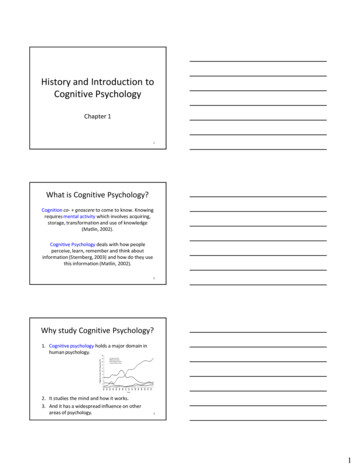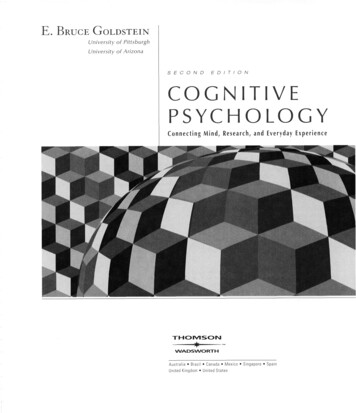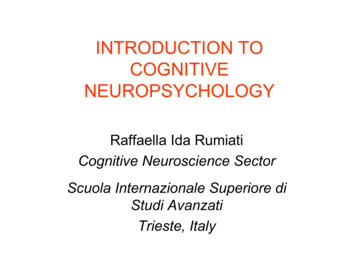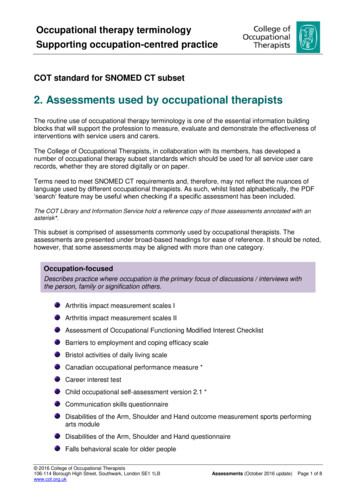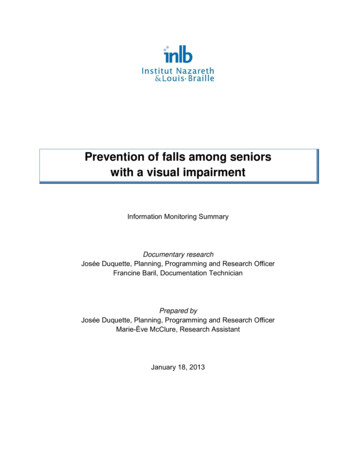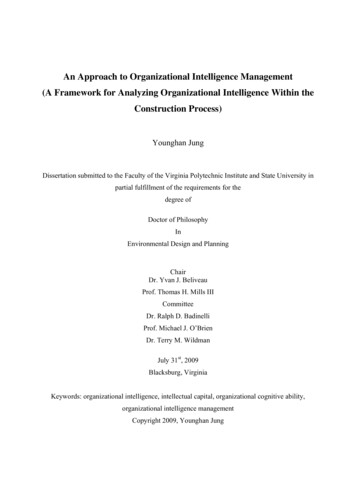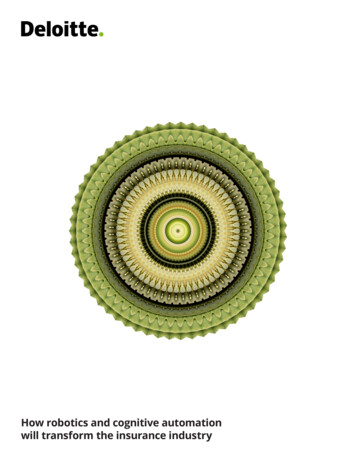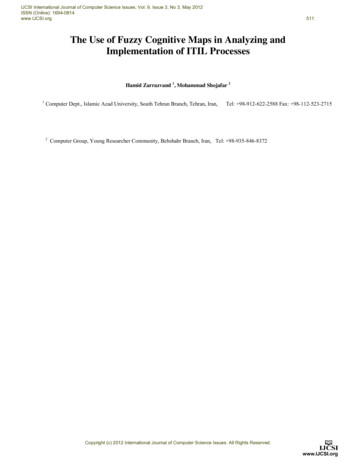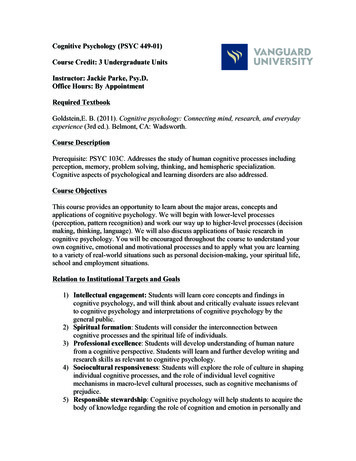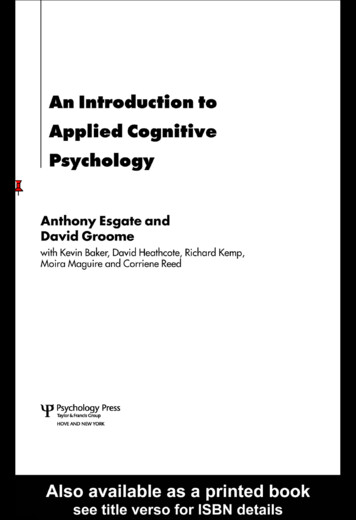
Transcription
An Introduction toApplied CognitivePsychology
An Introduction toApplied CognitivePsychologyAnthony Esgate andDavid Groomewith Kevin Baker, David Heathcote, Richard Kemp,Moira Maguire and Corriene Reed
First published 2005 by Psychology Press27 Church Road, Hove, East Sussex, BN3 2FASimultaneously published in the USA and Canadaby Psychology Press270 Madison Avenue, New York, NY 10016This edition published in the Taylor & Francis .e-Library, 2004.Psychology Press is part of the Taylor & FrancisGroupCopyright 2005 Psychology Press“To purchase your own copy of this or any ofTaylor & Francis or Routledge’s collectionof thousands of eBooks please go to www.eBookstore.tandf.co.uk.”All rights reserved. No part of this book may bereprinted or reproduced or utilised in any form orby any electronic, mechanical, or other means,now known or hereafter invented, includingphotocopying and recording, or in any informationstorage or retrieval system, without permission inwriting from the publishers.The publisher makes no representation, express orimplied, with regard to the accuracy of theinformation contained in this book and cannotaccept any legal responsibility or liability for anyerrors or omissions that may be made.This publication has been produced with papermanufactured to strict environmental standards andwith pulp derived from sustainable forests.British Library Cataloguing in Publication DataA catalogue record for this book is available fromthe British LibraryLibrary of Congress Cataloging-in-Publication DataAn introduction to applied cognitive psychology /Anthony Esgate & David Groome; with Kevin Baker. . . [et al.].p. cm.Includes bibliographical references and index.ISBN 1-84169-317-0—ISBN 1-84169-318-9 (pbk.)1. Cognitive psychology. 2. Psychology, Applied.I. Esgate, Anthony, 1954– II. Groome, David,1946– . III. Baker, Kevin.BF201.156 2004153—dc222004008923ISBN 0-203-50460-7 Master e-book ISBNISBN 0-203-59522-X (Adobe eReader Format)ISBN 1-84169-317-0 (Hbk)ISBN 1-84169-318-9 (Pbk)
To my parents, Reg and Barbara (DG)For Deanna and Snowball (AE)v
ContentsLIST OF FIGURES AND TABLESFIGURE ACKNOWLEDGEMENTSABOUT THE AUTHORSxxixxiixxiiiPREFACE1xviiIntroduction to applied cognitivepsychology11.1APPLIED COGNITIVE PSYCHOLOGY21.2EARLY COGNITIVE RESEARCH21.3POST-WAR DEVELOPMENTS IN APPLIED COGNITIVE PSYCHOLOGY31.4LABORATORY VERSUS FIELD EXPERIMENTS51.5THE AIMS OF APPLIED COGNITIVE PSYCHOLOGY71.6ABOUT THIS BOOK72Memory improvement92.1INTRODUCTION102.2ORGANISING AND SPACING OF LEARNING SESSIONS102.3MEANING, ORGANISATION AND IMAGERY AS LEARNING STRATEGIES122.4MNEMONICS18vii
CONTENTSMnemonic strategiesExpert mnemonists182.5RETRIEVAL AND RETRIEVAL CUES242.6RETRIEVAL PRACTICE AND DISUSE272.7RETRIEVAL-INDUCED FORGETTING282.8CLINICAL APPLICATIONS OF DISUSE AND RETRIEVAL INHIBITION302.9RETRIEVAL STRENGTH, STORAGE STRENGTH AND METAMEMORY32SUMMARY33FURTHER READING343Everyday memory353.1INTRODUCTION: MEMORY IN THE LABORATORY AND IN REAL LIFE363.2AUTOBIOGRAPHICAL MEMORY37Memory for the distant pastDiary studies and retrieval cuesMemory for different periods of lifeInfantile amnesia37FLASHBULB MEMORIES42Memory for learning about shocking eventsDoes flashbulb memory involve a special process?Other factors affecting flashbulb memoryPhysiological and clinical aspects of flashbulb memory42EYEWITNESS TESTIMONY47The fallibility of eyewitness testimonyContamination by post-event informationThe Oklahoma bombingExplanations of contamination and misinformation effectsChildren as witnessesGeneral conclusions and recommendations47THE COGNITIVE INTERVIEW53Techniques used in the cognitive interviewThe effectiveness of the cognitive interviewLimitations of the cognitive interview53SUMMARY58FURTHER READING593.33.43.5viii2138394143454648495152535557
CONTENTS4Face G MODELS634.3DANGEROUS EVIDENCE: EYEWITNESS IDENTIFICATION65Researching the factors affecting identification accuracyMeta-analytic techniquesSystem variables and estimator variablesSurveys of experts65FACTORS AFFECTING IDENTIFICATION EVIDENCE67Identification proceduresRelative versus absolute judgementsSimultaneous and sequential identification procedures67INFLUENCING POLICY74The fifth recommendation764.6THE VIPER PARADE764.7MAKING FACES: FACIAL COMPOSITE SYSTEMS77Evaluating first-generation composite systemsSecond-generation composite systemsThe utility of composite systems78WHEN SEEING SHOULD NOT BE BELIEVING: FACING UP TO FRAUD83SUMMARY85Working memory and performancelimitations89INTRODUCTION90Working memoryThe Baddeley and Hitch model of working memoryIndividual differences in working memory capacity90WORKING MEMORY AND COMPUTER PROGRAMMING92Learning programming languagesExpert programming9293WORKING MEMORY AND AIR-TRAFFIC CONTROL94The role of working memory in the ATC taskSituation ix
CONTENTS5.45.596WORKING MEMORY AND INDUSTRIAL TASKS97Learning industrial tasksMultimedia training formats97WORKING MEMORY AND MENTAL CALCULATION99The role of working memory in mental calculationThe contribution of working memory componentsMultiple working memory componentsWorking memory and mathematics anxiety99969899101102WORKING MEMORY AND HUMAN–COMPUTER INTERACTION103Working memory errors in human–computer interactionElderly computer usersWorking memory and cognitive engineering in human–computer interactionMotor working memory in human–computer interaction103SUMMARY1076Skill, attention and cognitive failure1096.1INTRODUCTION1106.2SKILL AND ITS ACQUISITION110Divided attention and dual-task performancePractice and the development of automaticity1126.3COGNITIVE FAILURE: SKILL BREAKDOWN1176.4SKILL BREAKDOWN: HUMAN ERROR121The price of automaticityA taxonomy of error typesLaboratory-induced errors1216.5MINIMISING ERROR THROUGH DESIGN1276.6A CASE STUDY OF “HUMAN ERROR”131SUMMARY134FURTHER READING1355.6xVoice communicationStructural interference in ATC tasks103104106115122126
CONTENTS7Biological cycles and IAN RHYTHMS138EntrainmentCircadian clocks1417.3THE CIRCADIAN RHYTHM AND PERFORMANCE1427.4CIRCADIAN DISRUPTION144Jet-lagShift-workFatigue and performance144THE MENSTRUAL CYCLE147The biology of the menstrual cycleThe menstrual cycle in context148STUDYING THE MENSTRUAL CYCLE150Methodological issues151THE MENSTRUAL CYCLE AND PERFORMANCE153The menstrual cycle and arousalSensation and perceptionCognitive performance1537.57.67.71411451471501541547.8A ROLE FOR GONADAL HORMONES IN COGNITION?1557.9WORK PERFORMANCE158Beliefs about performance159SUMMARY160FURTHER READING1618Drugs and cognitive performance1638.1INTRODUCTION164The social drugsIllegal drugs166CAFFEINE166The effects of caffeine on cognitive performanceReaction timeMemory and learningAttention and alertnessCaffeine and low arousal1678.2166168168169170xi
CONTENTS8.3Methodological issuesConclusions170ALCOHOL172The effects of alcohol on cognitionReaction timeMethodological issuesAlcohol and driving performanceEffects of chronic alcohol consumptionAlcohol 76176177NICOTINE177Nicotine and cognitionAnimal studies of the effects of nicotine on cognitionHuman studiesReaction timeLearning and memoryAttentionImplications for TIVE EFFECTS OF THE SOCIAL DRUGS ON COGNITION183Alcohol and nicotineAlcohol and caffeineNicotine and caffeineConclusions183CANNABIS184Cannabis and cognitive performanceMemoryConclusions185ECSTASY186Ecstasy and cognitionMemory and executive functionConclusions187COCAINE AND AMPHETAMINES189Stimulants and cognitionConclusions190SUMMARY191FURTHER READING192183184184185186188189190
CONTENTS9Intuitive statistics, judgements anddecision making1939.1INTRODUCTION1949.2DEFINITIONS OF PROBABILITY195The law of large numbers1969.3A LITTLE BIT OF THEORY 1: INDEPENDENT EVENTS1979.4HEURISTICS AND BIASES 1: REPRESENTATIVENESS, CONFIRMATIONBIAS, THE GAMBLER’S FALLACY AND THE CONJUNCTION FALLACY9.5199HEURISTICS AND BIASES 2: RANDOMNESS, AVAILABILITY,ADJUSTMENT/ANCHORING, ILLUSORY CORRELATION,REGRESSION TO THE MEAN, FLEXIBLE ATTRIBUTION, SUNK-COST BIAS 2009.6APPLICATIONS 1: LOTTERIES, UNREMARKABLE COINCIDENCES,PARANORMAL BELIEF, UNPROVEN TREATMENTS202The lotteryUnremarkable coincidencesBelief in the paranormalUnproven medical treatments2029.7A LITTLE BIT OF THEORY 2: CONDITIONAL PROBABILITY2089.8HEURISTICS AND BIASES 3: NEGLECT OF BASE RATES2099.9APPLICATIONS 2: SOCIAL JUDGEMENT, STEREOTYPING, PREJUDICE,9.10205206208ATTITUDE TO RISK, MEDICAL DIAGNOSIS210Social judgement, stereotyping and prejudiceAttitude to riskMedical diagnosis210210212DECISION MAKING: FRAMING EFFECTS, RISK AVERSION,OVERCONFIDENCE, HINDSIGHT BIAS213APPLICATIONS 3: A COUPLE OF BRAINTEASERS215The despicable Dr Fischer’s bomb partyThe Monty Hall problem215SUMMARY216FURTHER READING21710Auditory perception21910.1INTRODUCTION22010.2SOUND, HEARING AND AUDITORY PERCEPTION220What is sound?2209.11216xiii
CONTENTSWhat is the auditory system?Seeing and hearing223APPROACHES TO STUDYING AUDITORY PERCEPTION225PsychophysicsGestalt psychologyGibson’s ecological approachAuditory scene analysis225AREAS OF RESEARCH233LocalisationNon-speech soundsSpeech perceptionAttention and distractionInteraction with the other senses233242APPLICATIONS OF AUDITORY PERCEPTION RESEARCH244The applied use of soundSonificationWarning soundsMachine speech recognitionForensic applications (earwitnesses)244249SUMMARY251FURTHER READING25111Reading and dyslexia25311.1INTRODUCTION25411.2ACQUIRED DYSLEXIA25411.3PERIPHERAL AND CENTRAL DYSLEXIA25411.4MODELS OF ACQUIRED DYSLEXIA255Computational models of acquired dyslexia25711.5DIFFERENT FORMS OF ACQUIRED DYSLEXIA258Surface dyslexiaInput surface dyslexiaCentral surface dyslexiaOutput surface dyslexiaDo surface dyslexic patients have the same locus of impairment?Acquired dyslexia in which there is reading without meaning:evidence for Route 259259260260260
CONTENTSPhonological dyslexiaDeep dyslexia26211.6ASSESSMENT OF ACQUIRED DYSLEXIA26411.7REHABILITATION265262Cross-over treatment design26611.8DEVELOPMENTAL DYSLEXIA26711.9DEFINITIONS OF DEVELOPMENTAL DYSLEXIA26811.10DYSLEXIA IN THE SCHOOL SETTING26911.11DYSLEXIA IN THE WORKPLACE270SUMMARY271FURTHER READING272USEFUL ORGANISATIONS272REFERENCES273SUBJECT INDEX309AUTHOR INDEX315xv
Figures and tablesFigures1.1 Frederic Bartlett1.2 Donald Broadbent1.3 Ulric Neisser2.1 Massed and spaced learning sessions2.2 Expanding retrieval practice2.3 The effect of different types of input processing on wordrecognition (percent recognised)2.4 Elaborative connections between memory traces2.5 An interactive image2.6 A tree diagram2.7 A hedgehog with its “hairy son” (L’Herrison)2.8 Running times as used as a mnemonic strategy by SF2.9 Retrieval pathways leading to a memory trace2.10 A context reinstatement experiment2.11 Memory traces competing for a retrieval pathway2.12 Retrieval-induced inhibition (the retrieval of trace 1 inhibitsretrieval of trace 2, which shares the same retrieval cue)2.13 Retrieval-induced inhibition used to inhibit memory causinganxiety or panic response3.1 A school photograph3.2 Retrieval scores for personal autobiographical events from differentperiods of an individual’s life3.3 President John F. Kennedy shortly before he was assassinated3.4 The World Trade Center attack3.5 Princess Diana3.6 Timothy McVeigh, the Oklahoma bomber3.7 The main techniques used in the cognitive interview 54xvii
FIGURES AND 27.37.47.57.67.77.87.97.108.18.28.38.48.5xviiiThe number of correct and incorrect statements made by witnessesunder three different interview conditionsThe face recognition model proposed by Bruce and Young (1986)Which is Larry’s nose?Who are these men?Can you name these famous faces?Examples of the photographs used on each of four types of creditcard used by “shoppers” in the study of Kemp et al. (1997)A model of working memory based on Baddeley and Logie (1999)A simplified representation of Dehaene’s “triple code model” ofnumerical processingStage model of a typical taskShiffrin and Schneider’s (1997) results of processing demands onresponse timeThe Yerkes-Dodson lawComputer dialogue confirmation boxCooker hob layoutsThe circadian cycleMelatonin releaseLocation of the hypothalamus and the pineal gland in the humanbrainFlying east and west requires a “phase advance” and “phase delay”,respectivelyThe menstrual cycle is regulated by the hypothalamic–pituitary–ovarian axisLevels of estrogen, progesterone, follicle-stimulating hormone andluteinising hormoneA summary of research findings on the relationships betweenmenstrual cycle phase and (1) arousal, (2) sensation and perceptionand (3) cognitive performanceWhen estrogen levels are high women perform better on femaleadvantage tasks and worse on male-advantage tasks, and viceversa when estrogen levels are lowThere appears to be an optimal level of testosterone forperformance on spatial tasks that is higher than that typicallyfound in women and to the low end of that typically found in menManipulation of women’s beliefs about their menstrual phaseDrugs can affect the ways in which neurons communicate, eitherdirectly or indirectlyThe location of the nucleus accumbens in the human brainCommon dietary sources of caffeineBonnet and Arnaud (1994) found that caffeine can enablesleep-deprived individuals to maintain baseline levels ofperformanceA unit of alcohol is the amount in a standard glass of wine, a UKpub measure of spirits or a half pint of standard strength beer 5148149155158158160164165167170172
FIGURES AND TABLES8.68.7Alcohol always impairs drivingSmoking is a particularly effective means of drug administration,allowing the user to control the amount of drug taken and ensuringthat it enters the circulation quickly8.8 Smoking reliably improves the performance of deprived smokers10.1 The waveforms of a pencil falling onto a table top, a mouth-organplaying the note of A, the author saying “hello”, and the authorsaying “hello” at the same time as a woman says “goodbye”10.2 Spectrograms of the author saying “hello” and of the authorsaying “hello” at the same time as a woman says “goodbye”10.3 The workings of the ear10.4 Diagrammatic representation of the spectrum of a mouth-organplaying the note of middle A10.5 Diagrams of two sounds10.6 Diagrammatic representation of the stimuli used by Ciocca andBregman (1987)10.7 Diagrammatic representation of the repeated tonal pattern used byBregman and Pinker (1978)10.8 In the horizontal plane, time and amplitude differences are used forlocalisation; in the vertical plane, spectral cues are used10.9 The spectra of a Spanish guitar playing the note of A with a strongharmonic at 220 Hz, and the spectra of a mouth-organ playing thenote of A with a strong harmonic at 880 Hz10.10 Diagrammatic spectrograms of artificial [ba] and [pa] phonemessynthesised with three formants11.1 A double dissociation11.2 A traditional model of reading11.3 A typical connectionist model of reading11.4 Effects of reading therapy on patient BSTables4.1 A summary of the findings of the survey of experts conducted byKassin et al. (2001)6.1 Norman’s (1981) classification of action slips6.2 The oak–yolk task7.1 The time and date in cities across the world7.2 Key methodological difficulties in menstrual cycle research7.3 A list of cognitive tasks that show small but reliable differencesbetween the sexes8.1 Summary of the inconsistencies in evidence for the effects ofcaffeine on cognition and performance8.2 Factors determining the effect a given dose of alcohol will have onan individual8.3 Rates of adult lifetime, previous year and previous month use ofcannabis in England and Wales in 19988.4 Percentage of adults in England and Wales who had ever usedecstasy, amphetamines and cocaine in 5826768122127144151156171174184187xix
FIGURES AND TABLES9.111.111.211.3xxProportions of individuals preferring each position in the queue atDr Fischer’s partySummary of characteristics of the peripheral dyslexiasTasks used to assess components of readingFactors that can affect a dyslexic child in school215255265269
Figure acknowledgementsSources for figures reproduced in this book are acknowledged as follows:Figure 1.1 Reproduced with the kind permission of the Department of Experimental Psychology, University of CambridgeFigure 1.2 Reproduced with the kind permission of the MRC Cognition andBrain Sciences UnitFigure 1.3 Reproduced with the kind permission of Ulric NeisserFigure 3.1 Reproduced with the kind permission of David T. Lawrence ofJ.C. Lawrence & Sons (photographers)Figure 3.3 CREDIT: Popperfoto.comFigure 3.4 CREDIT: Popperfoto.comFigure 3.5 CREDIT: Popperfoto.comFigure 3.6 CREDIT: Popperfoto.comFigure 4.1 Reproduced with the kind permission of Vicki BruceFigure 6.2 Reproduced with the kind permission of Psychology PressFigure 6.3 Reproduced with the kind permission of Psychology Pressxxi
About the authorsAnthony Esgate, David Groome, Moira Maguire and Corriene Reed are all lecturersin the Psychology Department of the University of Westminster, London. KevinBaker is at the University of Leicester, David Heathcote is at the University ofBournemouth and, finally, Richard Kemp is at the University of New South Wales.The authorship of individual chapters is as follows:Chapter 1: David GroomeChapter 2: David GroomeChapter 3: David GroomeChapter 4: Richard KempChapter 5: David HeathcoteChapter 6: Anthony EsgateChapter 7: Moira MaguireChapter 8: Moira MaguireChapter 9: Anthony EsgateChapter 10: Kevin BakerChapter 11: Corriene Reedxxii
PrefaceWe decided to write this book because we could not find any other current titlescovering the field of applied cognitive psychology adequately. There are plenty ofbooks about cognitive psychology, but none of them deal specifically with theapplication of cognitive psychology to real-life settings. This seemed rather odd tous, but it probably reflects the fact that applied cognitive psychology is a relativelynew science. Applied cognitive psychology has only really begun to take off as amajor research area over the last 20–30 years, and even in recent times the applications of cognitive research have been relatively sparse and sometimes of doubtfulvalue. It is only now beginning to be accepted that cognitive psychologists really dohave something useful to say about real-life situations.We have tried to collect together in this book some of the most importantexamples of the application of applied cognitive research. There are chapters aboutimproving the effectiveness of your learning and exam revision, improving theaccuracy of eyewitnesses, and optimising the performance of individuals workingunder stress and multiple inputs, such as air-traffic controllers. There are alsochapters about the effects of drugs and circadian rhythms on cognitive performance, and on the factors that cause errors in our decision making. These are all areasin which the findings of cognitive psychologists have actually been put to use in thereal world. Being a new and developing area, applied cognitive psychology remainssomewhat incomplete and fragmented, so inevitably the chapters of this book tendto deal with separate and fairly unrelated topics. One advantage of this fragmentation is that you can read the chapters in any order you like, so you can dip into anychapter that interests you without having to read the others first.One problem when dealing with a relatively new and developing area of researchis that there is still no clear agreement about which topics should be included in abook of this kind. We have tried to pick out what we think are the main areas, butwe are well aware that not everyone will feel that our book is comprehensiveenough. No doubt there will be several topics that some of you may think shouldxxiii
PREFACEhave been included in the book but which aren’t. If so, perhaps you would be goodenough to write to us and tell us which topics you think we should have included,and we will think about including them in the next edition. In the meantime, wehope this book will help to fill a gap in the market, and with a bit of luck we hope itwill also fill a gap on your bookshelf.I would like to close by offering my thanks to the people at Psychology Press whohave helped us to produce this book, especially Ruben Hale, Dave Cummings, LucyFarr and Kathryn Russel. They are all very talented people, and they are also verypatient people.David GroomeP.S. Trying to write a book that can be applied to real-life settings is a considerablechallenge, but I would like to close by giving you one really clear-cut exampleof someone who succeeded in doing just this. It concerns a young man calledColin, who managed to get himself a job working behind the complaints desk of abig department store. On his first morning Colin’s boss presented him with anenormous training manual, explaining that it would provide him with the solutionto any complaint the customers could possibly come up with. Later that morningColin found himself confronted by a particularly tiresome customer, who seemed tohave an endless series of annoying complaints about his purchase. Rememberingthe advice he had received earlier, Colin picked up the training manual and usedit to strike the customer an enormous blow on the side of the head. As the customerslumped to the floor dazed, Colin noted with some satisfaction that his boss hadbeen absolutely right, as the training manual had indeed provided an effectivesolution to this particular complaint. As it turned out, his boss was rather lesspleased with Colin’s approach to customer relations, explaining to him that strikinga customer was not in accordance with normal company policy. “On the contrary”,Colin said, “I dealt with this complaint strictly by the book”. We hope you willfind ways of applying our book to situations you encounter in the real world, buthopefully not the way Colin did.xxiv
Chapter 1Introduction toapplied cognitivepsychology1.11.21.31.41.51.6Applied cognitive psychologyEarly cognitive researchPost-war developments in applied cognitive psychologyLaboratory versus field experimentsThe aims of applied cognitive psychologyAbout this book2235771
INTRODUCTION TO APPLIED COGNITIVE PSYCHOLOGY1.1 Applied cognitive psychologyCognitive psychology is the study of how the brain processes information. In moreeveryday terms, it is about the mental processes involved in acquiring and makinguse of knowledge and experience gained from our senses. The main processesinvolved in cognition are perception, learning, memory storage, retrieval and thinking, all of which are terms that are used in everyday speech and therefore alreadyfamiliar to most people. Various types of information are subjected to cognitiveprocessing, including visual, auditory, tactile, gustatory and olfactory information,depending on the sensory system detecting it. However, humans have alsodeveloped the use of symbolic language, which can represent any other form ofinformation. Thus language constitutes another important type of information thatmay be processed by the cognitive system.All of these various aspects of cognition have been extensively studied in thelaboratory, but in recent years there has been a growing interest in the applicationof cognitive psychology to situations in real life. This approach is known as appliedcognitive psychology, and it is concerned with the investigation of how cognitiveprocesses affect our behaviour and performance in real-life settings. It is thisresearch which provides the subject matter of this book.1.2 Early cognitive researchThe earliest experiments in cognitive psychology were carried out over a centuryago. Cognitive processes had long been of interest to philosophers, but it wasnot until late in the nineteenth century that the first attempts were made to bringcognitive processes into the laboratory and study them in a scientific way. Theearliest cognitive psychologists made important discoveries in fields such asperception and attention (e.g. Wundt, 1874), imagery (Galton, 1883), memory(Ebbinghaus, 1885) and learning (Thorndike, 1914). This early work was mainlydirected at the discovery of basic cognitive processes, which, in turn, led to thecreation of theories to explain the findings obtained. New techniques of researchand new experimental designs were developed in those early days that were to be oflasting value to later cognitive psychologists.In some cases, this early research produced findings that could be applied inreal-life settings, but this was not usually the main purpose of the research. Forexample, Ebbinghaus (1885), while investigating the basic phenomena of memory,discovered that spaced learning trials were more effective than massed trials.Subsequently, spaced learning came to be widely accepted as a useful strategyfor improving the efficiency of learning and study (see Chapter 2 for moredetails). However, despite a few examples of this kind where research led to real-lifeapplications, the early cognitive researchers were mostly concerned with pureresearch and any practical applications of their findings were largely incidental.This approach was later challenged by Bartlett (1932), who argued that cognitiveresearch should have relevance to the real world. Bartlett suggested that cognitiveresearchers should make use of more naturalistic experimental designs and test2
INTRODUCTIONmaterials, bearing some resemblance to the situations encountered in real life.Bartlett’s research on memory for stories and pictures was of obvious relevanceto memory performance in real-world settings, such as the testimony of courtroomwitnesses (see Chapter 3). His emphasis on the application of research was to have alasting influence on the future of cognitive psychology.1.3 Post-war developments in applied cognitive psychologyThe Second World War provided a major catalyst to the development of appliedcognitive psychology. The war produced dramatic improvements in technology,which placed unprecedented demands on the human beings who operated it.With the development of complex new equipment such as radar and high-speedcombat aircraft, the need to understand the cognitive capabilities and limitations ofFigure 1.1 Frederic Bartlett3
INTRODUCTION TO APPLIED COGNITIVE PSYCHOLOGYhuman operators took on a new urgency. Consequently, the cognitive performanceof pilots, radar operators and air-traffic controllers emerged as an important area ofstudy, with the general goal of maximising operator performance and identifyingperformance limitations to be incorporated into equipment design. In the forefront of this new wave of applied research was the British psychologist DonaldBroadbent, who had trained as a pilot during the war and thus had first-handexperience of the cognitive problems encountered by pilots. Broadbent becameinterested in investigating the information-processing capabilities of human beings,and more specifically their ability to deal with two or more competing perceptualinputs (Broadbent, 1958). He investigated this by presenting his participants witha different input to each ear via headphones, a technique known as “dichoticlistening”. Broadbent was thus able to establish some of the basic limitations ofFigure 1.2 Donald Broadbent4
INTRODUCTIONhuman attention, and he was able to apply his findings to assisting the performanceof pilots and air-traffic controllers who often have to deal with two or more inputs atonce. Broadbent (1980) argued that real-life problems should not only be studied bycognitive psychologists but should ideally provide the starting point for cognitiveresearch, since this would ensure that the research findings would be valid (andpossibly useful) in the real world.1.4 Laboratory versus field experimentsAlthough applied cognitive research is intended to be applicable to the real world,this does not necessarily mean that it always has to be carried out in a real-worldsetting. Sometimes it is possible to recreate real-life situations in the laboratory, asin the case of Broadbent’s research on divided attention described above. However,in recent years there has been debate about whether cognitive psychology should beresearched “in the field” (i.e. in a real-world setting) or in the laboratory. Neisser(1976) argued that cognitive research should be carried out in real-world settingswherever possible, to ensure what he called “ecological validity”. By this Neissermeant that research findings should be demonstrably true in the real world, and notjust under laboratory conditions. Neisser pointed out the limitations of relying on abody of knowledge based entirely on research performed in artificial laboratoryconditions. For example, we know from laboratory work that people are subjectto a number of visual illusions, but we cannot automatically assume that thosesame illusions will also occur in everyday life, where such simple geometric formsare rarely encountered in isolation but tend to form part of a complex threedimensional visual array. Neisser was not only concerned with applied cognitiveresearch, as he felt that even theoretical research needed to be put to the test ofecological validity, to ensure that research findings were not merely created by theartificial laboratory environment.Neisser’s call for ecological validity has been taken up enthusiastically by manycognitive researchers over the last 25 years. However, as Parkin and Hunkin (2001)remarked in a recent review, the ecological validity movement has not achieved the“paradigm shift” that some had expected. One reason for this is the fact
psychology 1 1.1 applied cognitive psychology 2 1.2 early cognitive research 2 1.3 post-war developments in applied cognitive psychology 3 1.4 laboratory versus field experiments 5 1.5 the aims of applied cognitive psychology 7 1.6 about this book 7 2 memory improvement 9 2.1 introduct
